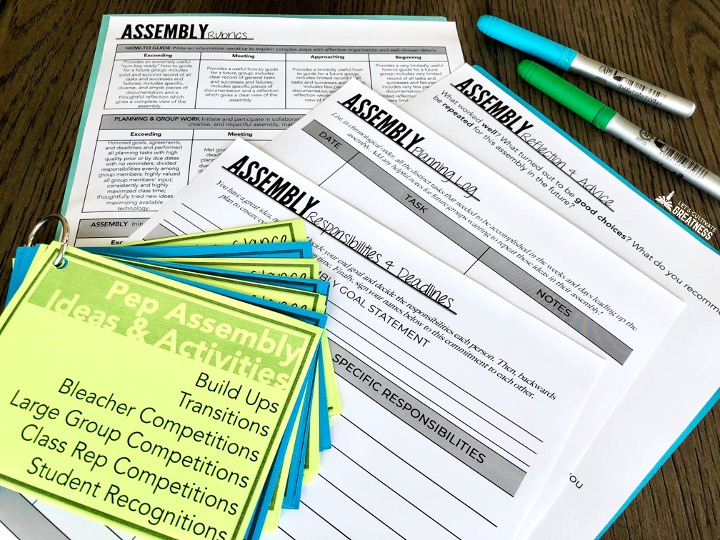Hosting assemblies was the most stressful part of my first few years as StucCo advisor, hands down.
Literally, my student leaders were on stage for the whole school to watch. And I was on the sidelines watching them succeed… or stumble.
It took a couple of years, but eventually I got the hang of the things I can do to help equip my students to plan a great assembly, allowing them to shine in front of their classmates.
For many teenagers an assembly is the first big event they’ve ever had to plan, so, like with anything, they need support and practice. Specifically, the skills of how to speak to a crowd and how to manage their allotted time.
Neither are common natural skills, but that doesn’t mean they can’t be taught with some simple activities and a little bit of practice ahead of time.
Here is my best advice for hosting a smooth and well-planned assembly, even if it’s your first time hosting one!
Practice the Mic
Speaking in front of the entire school is understandably nerve-wracking for most middle or high schoolers, especially when using a microphone for the first time.
That’s why it’s essential to get all your students comfortable speaking with one in front of others. If not, you’re going to have the same three kids hosting every assembly and really limit your students stepping outside their comfort zone.
Start early in the year setting the expectation that public speaking is a learned skill and everyone will practice it.
One of my favorite ways to do this is by starting with some low-risk icebreaker-type activities.
First, have students one at a time stand 20-30 yards from the rest of the group (the perfect excuse to head out to the football field!) and start by sharing, loudly and confidently, very short answers to questions. Things like their favorite ice cream flavor or if they like cats or dogs more.
After a few rounds of every student projecting their voice, switch to questions that take a few sentences to answer, like where they want to live as adults and why, or the strangest or most memorable food they’ve ever eaten.
Really any questions that everyone can answer are great ones to use for this.
Next, do the same activity in your gym or auditorium, wherever your assemblies take place. And this time, use the microphone. Let students get familiar with how close and how loud they need to speak into it while everyone else is sitting in the seats.
Not every student will want to be your assembly MCs and that’s okay, but doing these exercises will certainly open more of them to the idea of stepping up to the task. And it’s important in life to at least try things outside your comfort zone. I stress both these concepts when we do these activities.
Click to grab these and more communication skill building activities from my shop.
Plan for Transitions
Your assembly outline of course includes slots for all the main events, but be sure not forget all the transitions between them!
I have a whole flip deck of assembly games that also include these super necessary transition ideas.
For example, as your student leaders are setting up for their class competition game, what could a few others do to warm up the idle crowds in the bleachers?
Or, as kids are filing into the gym and getting seated, what could they be doing to set the right tone?
Some of my favorite quick transitions include taping small prizes under random seats or asking the crowd cheesy riddles or trivia questions.
For transitions that need a little more time, have your student leaders pre-record a “race” video between three students, displaying it on a screen, and have the crowd guess who will win. If you’ve been to a professional sports game, you’ve seen how everyone love these!
Or paint a large cardboard circle like a coin with a heads and tails side and have a student leader flip it in the center of the floor. Have the crowd stand up then shout out their guess for each flip, sitting down once they’re incorrect. The last person standing is the winner.
Click to grab these and more crowd-pleasing assembly games ideas from my shop.
Master the AV Equipment
Just like practicing speaking into a mic, treat handling the AV system as a skill everyone needs to at least attempt to learn.
Early in the year, like a week before your first assembly, give a walk-through of how to turn on, operate, and store all the AV equipment.
I’ve found it’s easiest to have one or two students be the designated AV people for the year, but you should avoid having only those two knowing how to hook up the speakers or where they’re stored!
Along with this, it’s a great idea to put together an AV checklist for before and after assemblies, to ensure things are located, charged, ready to go, and returned to where they’re stored.
The last thing you want five minutes before an assembly is figuring out which laptop dongle you need.
Prepare for Backup Games
Part of being prepared is having a back-up plan, especially when it’s a time-constrained event like an exactly-40-minute assembly.
My first year advising, I noticed immediately the time management piece was the hardest for my students. Various segments wouldn’t take anywhere as long as planned or they would run way over time.
Be sure to chat early with your assembly committee, ensuring necessary events are towards the beginning and identifying segments that can be shortened or cut out easily if time is limited.
Plus, just like emergency sub plans, have students create an emergency stash of a few no-prop spontaneous games and transition activities. Then if your mic is having issues or you have an awkward 5 minutes left at the end, they can handle it seamlessly!
Always Hold a Dress Rehearsal
Always. No matter how basic it is.
We’ve even done our run-throughs in the hallway because the gym was being used for testing. And it was fine.
With my students, I require a dress rehearsal the day before any assembly we host. As a bonus, this serves perfectly as the hard deadline for having all our props, supplies, and scripts done and packed.
It’s also a time to realize if we’ve forgotten to plan for a transition, if the order of things would be better swapped, or simply if the scripts need some tweaking.
The dress rehearsal date is prominently listed on our planning timeline and I stress to my student leaders that if they aren’t ready for it, the real assembly will be canceled. So far it hasn’t come to that!
Check out this blog post on what else is included in my assembly planning timeline if you want to learn more.
This day-before deadline has really improved their planning skills (and reduced my stress!), as it stops them from thinking they can leave class early the day-of to prepare, or otherwise scramble for major things at the last minute.
If you’d like to take the chaos out of planning your next assembly, you’ll definitely want to check out my Ultimate Assembly Planning Kit, which includes all the brainstorming, planning, and debriefing forms you’ll need to host a great event without the headache. Plus, included in the kit is a flip deck of spirit assembly game ideas to make your events inclusive and positive for all students.

Feature image credit: Robinson Recalde








